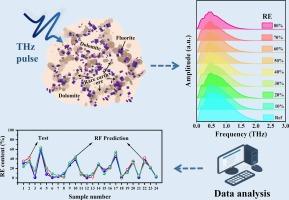利用太赫兹时域光谱对稀土矿进行定量表征
IF 3.4
3区 物理与天体物理
Q2 INSTRUMENTS & INSTRUMENTATION
引用次数: 0
摘要
巴彦奥博矿床是世界上最大的稀土、铁和铌多金属伴生矿床,其物理性质的稀有性限制了人们对其规律的认识和理解。以巴彦奥博高品位混合稀土精矿为研究对象,在传统的 X 射线荧光(XRF)、X 射线衍射(XRD)、扫描电子显微镜(SEM)和热重-差热分析(TG-DTA)的基础上,采用太赫兹时域光谱(THz-TDS)对高品位稀土精矿进行了系统研究。太赫兹时域光谱法研究了高品位稀土矿及其伴生矿物萤石和白云石的吸收系数和折射率。太赫兹光谱响应受矿物类型及其含量的影响。获取的稀土太赫兹光谱数据经过相关分析处理。利用三种机器学习算法,即部分最小二乘法回归(PLSR)、随机森林(RF)和多层感知器(MLP),实现了对其浓度和成分的定量检测,光学参数吸收系数的判定系数 R2 分别达到 0.975、0.992 和 0.984。这项工作促进了人们对含稀土矿物太赫兹透射光谱学的进一步了解,可用于指导寻找矿物,以及在地质学中探测、识别和量化矿物。太赫兹时域光谱学为研究稀土资源和巴彦奥博矿床资源的综合开发利用提供了一种新方法。本文章由计算机程序翻译,如有差异,请以英文原文为准。

Quantitatively characterization of rare earth ore by terahertz time-domain spectroscopy
The Bayan Obo deposit is the world’s largest polymetallic associated minerals deposit of rare earths, iron and niobium, and the rarity of its physical properties restrict the knowledge and understanding of its laws. Taking the high-grade mixed rare earth concentrate of Bayan Obo as the research object, terahertz time-domain spectroscopy (THz-TDS) has been adopted for the systematic investigation of high-grade rare earth concentrate base on the traditional X-ray fluorescence (XRF), X-ray diffraction (XRD), scanning electron microscopy (SEM) and thermogravimetric-differential thermal analysis (TG-DTA). The absorption coefficient and refractive index of high-grade rare earth ores and their associated minerals of fluorite and dolomite, are all investigated by terahertz time-domain spectroscopy. The terahertz spectral response is affected by the type of mineral and its content. The acquired rare earth terahertz spectral data are processed by correlation analysis. Three machine learning algorithms, Partial Least Squares Regression (PLSR), Random forest (RF) and Multilayer Perceptron (MLP), are used to achieve quantitative detection of their concentrations and components with the coefficient of determination R2 of the absorption coefficient of the optical parameter reaching up to 0.975, 0.992 and 0.984, respectively. This work promotes the growing understanding of terahertz transmission spectroscopy of rare earth-bearing minerals, which can be used to help guide the search for minerals, and to detect, identify as well as quantify them in geology. Terahertz time-domain spectroscopy supplies a new method for study of rare earth resources, and the comprehensive development and utilization of resources in the Bayan Obo deposit.
求助全文
通过发布文献求助,成功后即可免费获取论文全文。
去求助
来源期刊
CiteScore
5.70
自引率
12.10%
发文量
400
审稿时长
67 days
期刊介绍:
The Journal covers the entire field of infrared physics and technology: theory, experiment, application, devices and instrumentation. Infrared'' is defined as covering the near, mid and far infrared (terahertz) regions from 0.75um (750nm) to 1mm (300GHz.) Submissions in the 300GHz to 100GHz region may be accepted at the editors discretion if their content is relevant to shorter wavelengths. Submissions must be primarily concerned with and directly relevant to this spectral region.
Its core topics can be summarized as the generation, propagation and detection, of infrared radiation; the associated optics, materials and devices; and its use in all fields of science, industry, engineering and medicine.
Infrared techniques occur in many different fields, notably spectroscopy and interferometry; material characterization and processing; atmospheric physics, astronomy and space research. Scientific aspects include lasers, quantum optics, quantum electronics, image processing and semiconductor physics. Some important applications are medical diagnostics and treatment, industrial inspection and environmental monitoring.

 求助内容:
求助内容: 应助结果提醒方式:
应助结果提醒方式:


